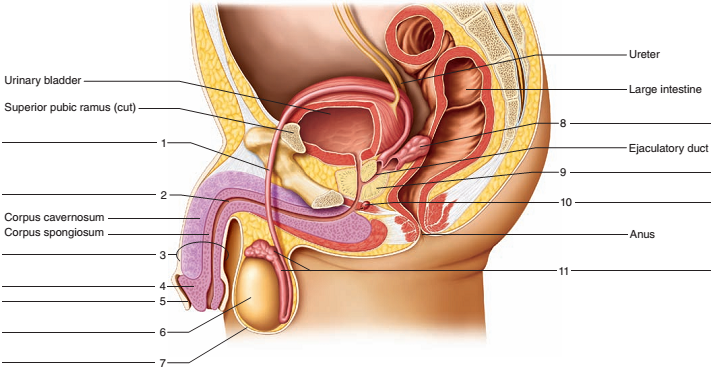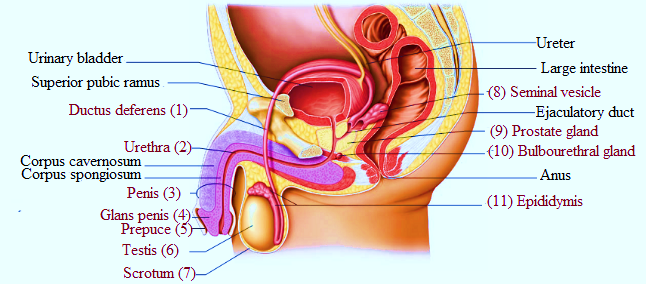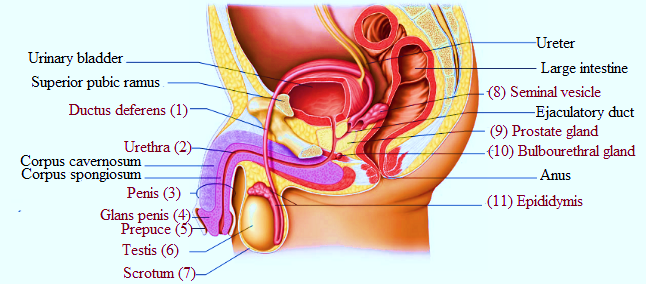

FIGURE 50.1 Label the major structures of the male reproductive system ih this sagittal view.
To label:
The given figure of sagittal section of the male reproductive system.
Introduction :
The reproductive system of a male is composed of external sex organs and organs in the pelvis region that helps in the reproduction of new offspring. The production of sperm is the main motive of male reproductive system. This system includes various organs, such as, testes, penis, ducts and glands, and epididymites.
Explanation of Solution
The figure of sagittal section of the male reproductive system as shown below:

1. Ductus deferens - The ductus deferens is a tube that carries sperm from the epididymis to the ejaculatory duct.
2. Urethra − It is a passage for sperm and urine in the male reproductive system.
3. Penis - In males, the penis is the organ to pass urine and ejaculate sperm.
4. Glans penis − It is the rounded tip at the head of the penis.
5. Prepuce − The foreskin of the penis.
6. Testis - It is a pair of glands that produce sperms. It is an important organ in the male reproductive system.
7. Scrotum − It is a sac-like structure that holds testicles.
8. Seminal vesicle - They are vesicular paired tubular glands that are present posteroinferior to the urinary bladder in males.
9. Prostate gland - The prostate gland is present in between the bladder and the penis. The function of this gland is to produce fluid to nourish sperms. It is a single gland.
10. Bulbourethral gland - Bulbourethral are the pea-shaped paired glands located below the prostate gland. The function of this gland is to add fluid to semen at the time of ejaculation.
11. Epididymis - A coiled and long tube that is located at the posterior surface of the testis is termed as epididymis. The purpose of epididymis is to store and transport sperm from the testis to the vas deferens.
Labeling the given figure of sagittal section of the male reproductive system as shown below:

Want to see more full solutions like this?
Chapter 50 Solutions
Laboratory Manual for Holes Human Anatomy & Physiology Fetal Pig Version
- What is the result of the following gram stain: positive ○ capsulated ○ acid-fast ○ negativearrow_forwardWhat type of stain is the image below: capsule stain endospore stain gram stain negative stain ASM MicrobeLibrary.org Keplingerarrow_forwardWhat is the result of the acid-fast stain below: Stock Images by Getty Images by Getty Images by Getty Images by Getty Image Getty Images St Soy Getty Images by Getty Images by Getty Images Joy Getty encapsulated O endosporulating negative ○ positivearrow_forward
- You have a stock vial of diligence 75mg in 3ml and need to draw up a dose of 50mg for your patient.how many mls should you draw up to give this dosearrow_forwardYou are recquired to administer 150mg hydrocortisone intravenously,how many mls should you give?(stock =hydrocortisone 100mg in 2mls)arrow_forwardIf someone was working with a 50 MBq F-18 source, what would be the internal and external dose consequences?arrow_forward
- We will be starting a group project next week where you and your group will research and ultimately present on a current research article related to the biology of a pathogen that infects humans. The article could be about the pathogen itself, the disease process related to the pathogen, the immune response to the pathogen, vaccines or treatments that affect the pathogen, or other biology-related study about the pathogen. I recommend that you choose a pathogen that is currently interesting to researchers, so that you will be able to find plenty of articles about it. Avoid choosing a historical disease that no longer circulates. List 3 possible pathogens or diseases that you might want to do for your group project.arrow_forwardnot use ai pleasearrow_forwardDNK dagi nukleotidlar va undan sintezlangan oqsildagi peptid boglar farqi 901 taga teng bo'lib undagi A jami H boglardan 6,5 marta kam bo'lsa DNK dagi jami H bog‘lar sonini topingarrow_forward
- One of the ways for a cell to generate ATP is through the oxidative phosphorylation. In oxidative phosphorylation 3 ATP are produced from every one NADH molecule. In respiration, every glucose molecule produces 10 NADH molecules. If a cell is growing on 5 glucose molecules, how much ATP can be produced using oxidative phosphorylation/aerobic respiration?arrow_forwardIf a cell is growing on 5 glucose molecules, how much ATP can be produced using oxidative phosphorylation/aerobic respiration?arrow_forwardHow do i know which way the arrows go?arrow_forward
 Human Biology (MindTap Course List)BiologyISBN:9781305112100Author:Cecie Starr, Beverly McMillanPublisher:Cengage Learning
Human Biology (MindTap Course List)BiologyISBN:9781305112100Author:Cecie Starr, Beverly McMillanPublisher:Cengage Learning Biology 2eBiologyISBN:9781947172517Author:Matthew Douglas, Jung Choi, Mary Ann ClarkPublisher:OpenStax
Biology 2eBiologyISBN:9781947172517Author:Matthew Douglas, Jung Choi, Mary Ann ClarkPublisher:OpenStax Human Physiology: From Cells to Systems (MindTap ...BiologyISBN:9781285866932Author:Lauralee SherwoodPublisher:Cengage Learning
Human Physiology: From Cells to Systems (MindTap ...BiologyISBN:9781285866932Author:Lauralee SherwoodPublisher:Cengage Learning Anatomy & PhysiologyBiologyISBN:9781938168130Author:Kelly A. Young, James A. Wise, Peter DeSaix, Dean H. Kruse, Brandon Poe, Eddie Johnson, Jody E. Johnson, Oksana Korol, J. Gordon Betts, Mark WomblePublisher:OpenStax College
Anatomy & PhysiologyBiologyISBN:9781938168130Author:Kelly A. Young, James A. Wise, Peter DeSaix, Dean H. Kruse, Brandon Poe, Eddie Johnson, Jody E. Johnson, Oksana Korol, J. Gordon Betts, Mark WomblePublisher:OpenStax College





